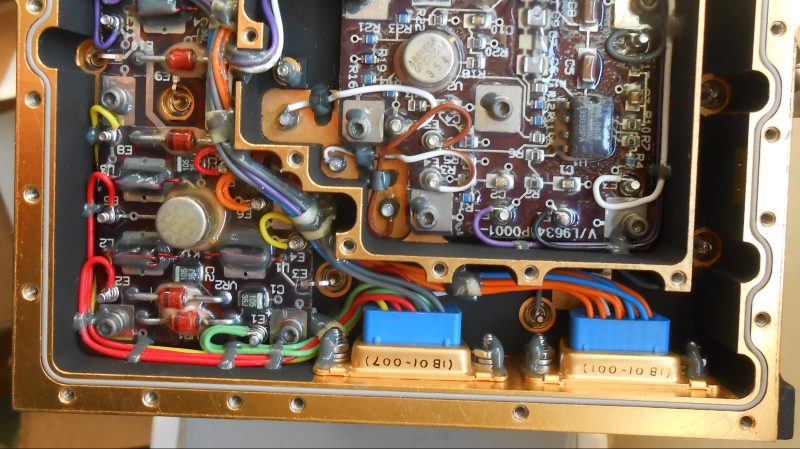As hackers, we’re always pulling stuff apart—sometimes just to see what it’s like inside. Most of us have seen the inside of a computer, television, and phone. These are all common items that we come into contact with every day. Fewer of us have dived inside real spacey satellite hardware, if only for the lack of opportunity. Some good gear has landed on [Don]’s desk over the years though, so he got to pulling it apart and peering inside.
[Don] starts us off with a gorgeous… box… of some sort from Hughes Aircraft. He believes it to be from their Space & Communications group, and it seems to have something to do with satellite communications work. Externally, he gleans that it takes power and data hookups and outputs RF to, something… but he’s not entirely sure. Inside, we get a look at the old 90s electronics — lots of through hole, lots of big chunky components, and plenty of gold plating. [Don] breaks down the circuitry into various chunks and tries to make sense of it, determining that it’s got some high frequency RF generators in the 20 to 40 GHz range.
Scroll through the rest of [Don]’s thread and you’ll find more gems. He pulls apart a microwave transmitter from Space Micro — a much newer unit built somewhere around 2008-2011. Then he dives into a mysterious I/O board from Broad Reach, and a very old Hughes travelling wave tube from the 1970s. The latter even has a loose link to the Ford Motor Company, believe it or not.
Even if you don’t know precisely what you’re looking at, it’s still supremely interesting stuff—and all very satellite-y. We’ve seen some other neat satellite gear pulled apart before, too. Meanwhile, if you’ve been doing your own neat teardowns, don’t hesitate to let us know!















Now that headline was wasted – it would have been perfect with some spelling adjustments for a satellite subscription radio hack :P
Need some alien hardware teardowns.
I’ve never seen relays in a TO-99 (or similar) can, especially four of them in one can! Tiny!
Thanks for posting! I made the case for that Space Micro board and helped a bit (as a mechanical guy) on some of those boards.
I’ll have to get an account and reach out.
Awesome. Would like to hear more about that (esp. whether there’s an extra RFPA power management board I’m missing).
Actually the new iPhones hidden satellite mode as well which operates on the GPS satellite
No, they don’t. GPS is not a two way system. It’s not even a “hidden” mode, just check the help documents. iPhones are configured to transmit to conventional communications satellites like AST, Iridium, etc. Please at least verify speculations before posting online.
That’s not just “90” electronics. Modern mil-grade and rugged, high-power comm stuff is not by much different, only more custom ICs. What you consider “modern” in many cases is “cheap, planned to be obsolete in two years”.
Partly true: definitely not going to be any 0.4 mm BGAs, 01005-size components, and open-frame trimmers in things designed to be as rugged as possible. However, more modern military and aerospace stuff is still noticeably different, though, in that they use SMT components and less hand-wiring; see either this 2004 remote interface unit from a military aircraft (https://www.eevblog.com/forum/projects/reverse-engineering-misc-avionics-(part-3-raytheon-eas-diehl)/msg5467831/#msg5467831), or the Space Micro and Broad Reach boards in the same thread the article’s about.
I built and tested that box many years ago, you never forget, you are looking at old technology. In space business for 43 years, and no the Intelsat failure nothing to do with me or the company… any Q I would try answer but haven’t been well and now retired…cheers
Yeah, but you also know how reluctant we are to use new technology without flight heritage. So, there’s a lot of old stuff still being launched.
Very cool. Don’t want to bother you much in that case, but curious how accurate my guesses to its function were? (as a roughly Ka-band modulator/”exciter”)
The care in layout and the way that the wires are secured reminds me very much of the older tektronix gear. Made for quality, not to a price.
It warms my heart to see hardware like this. I spent the first 17 years of my career (1978-1995) working on aerospace hardware similar to this. We didn’t have or use any surface mount components until the ’90s, with the exception of some flat-pack IC’s (like early MSOPs). Notice how all the wiring is buttoned down with dabs of grey Castall cement, and most components are bonded as well. Once you’ve seen how hardware like this is built, inspected and tested (with S-level or at least Mil-Spec components), in very low volume, you understand why they were so expensive.